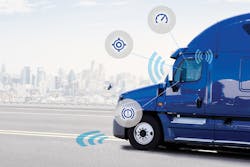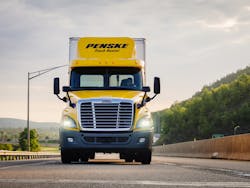Connectivity. It has become one of the most frequently used buzzwords within trucking. Often described as futuristic technology that must be developed to enable driverless vehicles, connectivity has actually been binding the industry together for decades.
“We’ve been connected for a long time. We called it telematics and fleet management systems,” said Fred Andersky, director of customer solutions and marketing for the Controls Group of Bendix Commercial Vehicle Systems.
Andersky explained the early days of connectivity generally consisted of a fleet’s home office receiving information about the vehicle or a driver.
Today, connectivity advancements are linking “the driver and the vehicle to the environment around them,” he said. That includes connections with nearby vehicles, the surrounding infrastructure, and even sensors within the tractor-trailer combination itself.
It is paving the way for equipment manufacturers to offer over-the-road programming, allowing for changing engine parameters and other time-sensitive updates without taking a truck off the road.
“Connectivity is a way primarily to increase the uptime for vehicles,” said Roger Nielsen, president and CEO of Daimler Trucks North America. “We want to change unscheduled maintenance and repair events to scheduled maintenance and repair events. That’s the whole idea with connectivity at the core.”
While these pieces may be stepping stones toward autonomous driving, consulting firm PricewaterhouseCoopers outlined the near-term advantages in a recent report.
“Advanced telematics will enable transportation companies, through cloud-based analytics, to track and monitor such factors as truck location, the health and fatigue of the driver, the temperature and barometric pressure of the freight, and so on,” the report said. “Telematics will also facilitate automated freight matching. The truck trailer, relying on sensors, will be able to determine available space and weight, route, and ETA, and transmit this information to software that can generate the most efficient and cost-effective scenarios for moving loads.”
The safety implications are equally as significant, with the National Highway Traffic Safety Administration estimating vehicle-to-vehicle communications can prevent or mitigate crashes not attributed to driver impairment by up to 80%.
The federal government has mandated some safety technologies on heavy-duty trucks, such as electronic stability control. Jon Morrison, WABCO president, Americas, said further mandates might not be needed as the industry learns more about connectivity.
“We really believe in the technology providing value, and once customers understand that, they are willing to adopt these products,” he said during an interview with Fleet Owner at the North America Commercial Vehicles (NACV) Show.
It was at that event where WABCO discussed its next generation OnGuard Max system, which can automatically brake in all weather conditions against stationary objects. The company also previewed OnLaneAssist, which combines steering and a forward-looking camera to provide lane-correction functionality.
Bendix showed several advancements at NACV as well, including the next generation of its Wingman Fusion system, scheduled for release during 2018.
Kerry Stritt, vice president of fleet services for Southeastern Freight Lines, said connected technology “supports good driving and makes our drivers better— even helping mitigate mistakes made by other drivers on the road.”
Research firm FTR said despite the cost of these systems, more fleets are showing a willingness to invest, especially with collision avoidance technology. “On top of the potentially foregone cost of collisions, the payback economics are also boosted by the lower risk of lawsuits and rate incentives from shippers,” FTR said.
Other connected systems include lane departure warning and predictive cruise control. Additionally, air disc brakes are viewed as a critical component to the success of these systems and to help for the move toward truck platooning.
Daimler Trucks North America (DTNA) offers many of these active safety systems through its Detroit brand. All truck makers are also focusing their connectivity efforts on keeping trucks out of the repair shop and squeezing more miles out of every gallon of diesel fuel.
For DTNA, that is accomplished through the Virtual Technician system, which monitors the vehicle and alerts drivers and fleet managers to fault events. Combined with Detroit Connect Analytics, it provides users targeted insight on fuel consumption and safety data.
Brian Kinsey, president and CEO of Brown Integrated Logistics, said his fleet benefits in numerous ways with Detroit’s connectivity. From automatic brake assist and lane warnings that improve driver behavior to receiving notifications about potential equipment issues before they happen, the system “gives us the data and information we need to address those issues now,” he said.
Meanwhile, Navistar Inc. announced numerous upgrades during the fall to its OnCommand Connection system. The open-architecture system monitors 325,000 vehicles traveling about 8.8 million miles a day, said Michael Cancelliere, president of Truck and Parts at Navistar. The goal, Cancelliere said, is to “get vehicles back on the road as quickly as possible, and no later than 48 hours after diagnosis.” He said OnCommand Connection has resulted in a 30% drop in unplanned maintenance, a figure likely to increase with the opening of its new Uptime Command Center within the company’s headquarters in Lisle, IL.
Navistar also launched the OnCommand Connection Marketplace in late October, offering drivers and fleet managers products and services in the connectivity space to operate more efficiently.
Volvo Trucks and Mack Trucks each have their own remote diagnostics systems, with the sister companies utilizing an Uptime Center to assist customers.
Mack’s system is known as GuardDog Connect, and it has partnered with Geotab to bring older vehicles into the connectivity revolution. In October, Mack entered into a memorandum of understanding with Lytx, a provider of video services, to enhance connectivity and safety options on vocational models.
Keith Brandis, director of product planning at Volvo Trucks, said the company has monitors in about 600,000 connected vehicles around the globe (200,000 in the U.S.). It is moving further into remote updates, allowing fleets to tailor vehicle parameters to different types of hauls or terrains.
Goran Nyberg, president of Volvo Trucks, compared these latest updates with the smartphone, noting that no one would purchase a particular phone if it needed to be brought into a store each time there was a recommended software update.
At a Kenworth Trucks event this summer, executives talked about the benefits—and potential dangers—of remote diagnostics data.
Kenworth Truck Tech+ covers more than 50,000 vehicles, which have traveled billions of miles. “It gives us a lot of information that we use to make our products better, said Kevin Baney, chief engineer. He added that the data allows dealers to improve their service and customers “to run their trucks better.”
At the same time, Kenworth general manager Mike Dozier said “security is a primary concern” when discussing connectivity. Besides ensuring the safety and privacy of data, it is especially important with over-the-air-updates that “customers have control” when they are scheduled and that a particular update fits into their overall business model.
Kenworth is a unit of Paccar Inc., which also owns Peterbilt Motors Co. Peterbilt has a similar remote diagnostics system called SmartLinq.
Besides truck makers, some fleets are taking connectivity into their own hands. For example, Penske Truck Leasing said it is building “a technological path to providing predictive vehicle maintenance” and reacting faster to calls for roadside assistance.
During 2017, the company launched a proprietary connected fleet solution that works with virtually every truck and engine configuration or telematics service provider.
“Our unique approach makes it easy for customers to connect their vehicles and share their vehicle data with us. We’ve designed these connected fleet solutions to improve vehicle uptime, safety and compliance, and help keep customers well-informed about their vehicles,” said Brian Hard, president and CEO of Penske Truck Leasing.
Despite a year full of steady connectivity advancements, research firm Stifel believes “safety and automation still have plenty of room to grow.” The commercial vehicle industry “remains behind the auto industry in development and adoption of advanced driver-assistance systems and other safety- and automation-related technology and components,” Stifel said.
With rising jury judgments and insurance premiums, fleets will be “increasingly motivated to invest” in technology and connectivity for years to come.
While connectivity comes in many forms, Bendix’s Andersky likes to remind customers not to overlook the simple importance it offers the truck driver.
Within a few years, cameras and sensors will be able to see all the way around the tractor-trailer. They will become more integrated into the overall vehicle, alerting to potential collisions at intersections ahead of time and helping drivers more easily avoid “bumps and scratches” while backing up a trailer into a tight space.
“That’s practical,” Andersky said.
Trailers begin to catch up to connectivity
The power of connectivity is rapidly expanding beyond the truck cab and to the trailer, where the drive for efficiency, federal regulations, and e-commerce demands requires real-time monitoring of a wide range of data.
“We do spend a lot of time talking about trucks,” said Jon Morrison, WABCO president, Americas. “The trailer is very much increasing in importance.” He called the trailer a “vital part of the overall system,” with major strides being made on connectivity and aerodynamics.
It was a message shared by Fred Andersky, director of customer solutions and marketing for the Controls Group of Bendix Commercial Vehicle Systems. He said many in the industry “are finally beginning to realize” the important role the trailer plays in safety and productivity.
One driver of trailer technology in the refrigerated sector has been the Food Safety Modernization Act. For example, at the North American Commercial Vehicle Show (NACV) in September, Thermo King unveiled its new Connected Precedent trailer refrigeration unit.
“Our remote connectivity … and data gathering allows fleet managers to transform their operations and make their fleets more predictable and traceable, which ultimately helps grow their business by driving greater optimization,” said Dane Taival, vice president and general manager at Thermo King North America.
Besides real-time monitoring by drivers through Bluetooth, the company said Connected Precedent makes it easier to prepare reefers for trips by ensuring that they are fueled and alarm-free.
David Kiefer, director of sales, marketing, and product management for Carrier Transicold, said it is critical that alarms are acted upon quickly, but also are routed to the proper people. While some warnings might require a driver’s immediate attention, if reefer temperatures begin to fluctuate, it might be better to inform other fleet personnel who have the tools to make adjustments remotely, he said.
Connectivity is at its best when it can remove drivers from having to be part of that equation. “We have to think in terms of what we do to enable the driver just to drive the truck,” Kiefer said.
Another benefit of connectivity can be simply helping to prevent a fleet from mistakenly hooking up the wrong trailer to a tractor.
Outside the trailer, there are other benefits. For example, WABCO has a boat tail that deploys and retracts at specific speeds, offering higher fuel economy. Additionally, retreading programs can track the condition of individual tires on a trailer equipped with RFID tags.
“Even some of the smallest components can create headaches, such as light outages,” said Dominic Grote, president and CEO of Grote Industries. Drivers need to be notified if lights go dark, but so do maintenance teams. That is why the company’s Guardian Smart Trailer System attaches to any type of trailer light and communicates with a smartphone or telematics system.
Fighting cargo theft is another driver for enhancing trailer connectivity, said Rob Phillips, president of Phillips Industries. The company’s new Connect: Security system stops theft by locking the air brakes on a trailer when power is disconnected from the tractor. The system includes a remote trailer door locking function and video surveillance system.
Bendix’s Andersky noted automated tire pressure monitoring can provide a big benefit with a minimal investment. He said fleets can be notified if a trailer tire heats up while the truck is in motion. The problem can be diagnosed and relayed to the driver to immediately pull off the road to avoid a serious incident, or to just make sure to check the tire pressure at the next scheduled stop.
Besides ensuring safety, staying on top of tire pressure can have a positive effect on the overall fuel economy of the rig, Andersky said.
About the Author
Neil Abt
Neil Abt is a former FleetOwner editor who wrote for the publication from 2017 to 2020. He was editorial director from 2018 to 2020.


